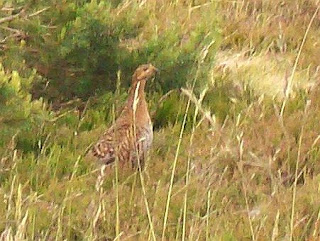
August saw the changeable weather continue, with seemingly no two consecutive days the same! This far North Autumn comes early, and later in the month the first signs were noted; shorter days, cooler mornings & evenings, Rowan trees full of their vivid red berries , a few leaves changing colour.
Bird day-lists remained around the 45-50 mark with many of the migrants now gone , and mammal day-lists were still good at 6-9 depending on our luck.
Wildlife highlights included:
An amazing close encounter with a very bedraggled-looking Scottish Wildcat one drizzly dawn - the fierce glare it gave us with it's wild orange eyes had to be seen to be believed!
A brief visit to a garden in our area by a Rose-Coloured Starling, a rare visitor to the UK, normally found much further East, it was enjoyed by a small number of keen birders , but sadly, not by me, as I missed it!
Our local juvenile Ospreys, now deserted by their parents, initially seemed lost without them & spent many hours calling in vain for them , but eventually seemed to accept their situation & knuckled down to some self-sufficient fishing.
A pair of lost/disorientated Sperm Whales turning-up in the Moray Firth, the initial joy & amazement soon turning to sadness, however, when one of them stranded, and sadly, despite the best efforts of many good people, died.
Also in the Moray Firth, the resident Dolphins delighted many with their super acrobatic displays , sometimes coming amazingly close to the shore.
Many of the local speciality birds such as Crested Tit, Scottish Crossbill, Red-Throated Diver, Black-Throated Diver, Slavonian Grebe, Osprey ,Red Grouse, Goldeneye & Golden Eagle continued to show, some more regularly than others of course, though all were seen during the month.
Mammals featured well during the month with the following all being seen at some stage;
Red Deer, Roe Deer (see pic), Reindeer, Sika Deer, Red Squirrel, Brown hare, Mountain hare, Mountain Goat, Stoat, & Bank Vole.







